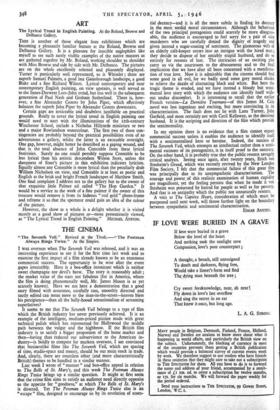ART
The Lyrical Trend in English Painting. At the Roland, Browse and Delbanco Gallery.
THIS is another of those elegant loan exhibitions which are becoming a pleasantly familiar feature at the Roland, Browse and Delbanco Gallery. It is a pleasure for irascible anglophiles like myself to see such rarely visible examples of the native masters as are gathered together by Mr. Roland, working shoulder to shoulder with Miss Browse and side by side with Mr. Delbanco. The pictures are on the whole excellently selected and pleasantly displayed. Turner is particularly well represented, so is Whistler ; there are superb Samuel Palmers, a good late Gainsborough landscape, a good Blake and a fine Richard Wilson. Lyrical contemporary and near contemporary English painting, on view upstairs, is well served as to the Innes-Derwent Lees-John trend, but less well in the subsequent generation of Paul Nash and Graham Sutherland. There is, how- ever, a fine Alexander Cozens by John Piper, which effectively balances the superb John Piper by Alexander Cozens downstairs.
Certain gaps are noticeable and doubtless justifiable on practical grounds. Really to cover the lyrical trend in English painting one would need to start with the illuminations of the tath-century Winchester School, include a Nicholas Hillyarde miniature or two and a major Rowlandson watercolour. The first two of these con- tingencies are probably beyond the practical possibilities even of so adventurous a gallery, whilst the latter is an excusable oversight. One gap, however, might better be described as a gaping wound, and that is the total absence of John Constable from these lyrical festivities. Surely no one could possibly suppose Constable to be less lyrical than his artistic descendant Wilson Steer, unless the dampness of Steer's picture in this exhibition indicates lyricism. Equally almost any Constable is more lyrical than the peculiarly drab William Nicholson on view, and Constable is at least as poetic and English as the brisk and bright French landscapes of Matthew Smith. One final complaint I address not to the gallery but to the owner of that exquisite little Palmer oil called " The Hop Garden." It would be a service to the work of a fine painter if the owner of this treasure would remove it from its hideous " real gold " photo-frame and reframe it so that the spectator could gain an idea of the colour of the picture.
However, the show as a whole is a delight whether it is visited merely as a good show of pictures or—more pretentiously viewed, as " The Lyrical Trend in English Painting." MICHAEL AYRTON.






























 Previous page
Previous page